
The centre of our Milky Way galaxy is located in the southern constellation Sagittarius (The Archer) and is "only" 26,000 light-years away. On high-resolution images, it is possible to discern thousands of individual stars within the central, one light-year wide region.
Using the motions of these stars to probe the gravitational field, observations over the last decade have shown that a mass of about 3 million times that of the Sun is concentrated within a radius of only 10 light-days of the compact radio and X-ray source SgrA* ("Sagittarius A") at the centre of the star cluster.
This means that SgrA* is the most likely counterpart of the black hole believed to exist at the centre of our Galaxy.

NASA's Hubble Space Telescope reveals the center of the magnificent barred spiral galaxy NGC 1512 in all wavelengths from ultraviolet to infrared. The colors (which indicate differences in light intensity) map where newly born star clusters exist in both 'dusty' and 'clean' regions of the galaxy.
NGC 1512 in the southern constellation of Horologium is located 30 million light-years away, relatively nearby as galaxies go, it is bright enough to be seen with amateur telescopes. The galaxy spans 70,000 light-years, nearly as much as our own Milky Way galaxy.
The galaxy's core is unique for its stunning 2,400 light-year-wide circle of infant star clusters, called a "circumnuclear" starburst ring. Starbursts are episodes of vigorous formation of new stars and are found in a variety of galaxy environments.
Taking advantage of Hubble's sharp vision, as well as its unique wavelength coverage, a team of Israeli and American astronomers performed one of the broadest and most detailed studies ever of such star-forming regions. The results show that in NGC 1512 newly born star clusters exist in both dusty and clean environments. The clean clusters are readily seen in ultraviolet and visible light, appearing as bright, blue clumps in the image. However, the dusty clusters are revealed only by the glow of the gas clouds in which they are hidden, as detected in red and infrared wavelengths by the Hubble cameras. This glow can be seen as red light permeating the dark, dusty lanes in the ring.
Circumstellar star-forming rings are common in the universe. Such rings within barred spiral galaxies may in fact comprise the most numerous class of nearby starburst regions.

On its 100,000th orbit of planet Earth, the Hubble Space Telescope peered into a small portion of the Tarantula Nebula near the star cluster NGC 2074, unveiling its stellar nursery. The region is a firestorm of raw stellar creation, triggered perhaps by a nearby supernova.

Images at three different epochs of the spiral galaxy NGC 2770, located 90 million light-years away towards the Lynx constellation, observed from the Asiago Observatory. The first image on 6 January 2008 reveals only the fading supernova SN 2007uy, which was discovered at the end of 2007. The second image, taken 6 days later, shows the newly discovered supernova SN 2008D. It is very rare for two supernovae to happen at the same time in a galaxy, as a supernova on average happens only once every hundred years. The last one to have been seen in our Milky Way dates back from 1604. The third image, taken almost a month later, still shows the two supernovae. SN 2007uy has faded, while SN 2008D brightened. The small animation shows an interpolation between these three images.

Located 9 000 light-years away, NGC 3576 is a gigantic region of glowing gas about 100 light-years across, where stars are currently forming. The intense radiation and winds from the massive stars are shredding the clouds from which they form, creating dramatic scenery. The black area in the right middle part of the image is dark because of the presence of very dense, opaque clouds of gas and dust.
The data used to make this colour-composite images were taken with ISAAC on the VLT, in the framework of observing proposal 079.C-0203(A). The image processing was done by Yuri Beletsky (ESO) and Hännes Heyer (ESO). It is based on data taken through 4 different narrow-band filters centred around 1.21, 1.71, 2.09 and 3.28 microns.

This new image of the luminous blue variable Eta Carinae was taken with the NACO near-infrared adaptive optics instrument on ESO's Very Large Telescope, yielding an incredible amount of detail. The images clearly shows a bipolar structure as well as the jets coming out from the central star.
The image was obtained by the Paranal Science team and processed by Yuri Beletsky (ESO) and Hännes Heyer (ESO). It is based on data obtained through broad (J, H, and K; 90 second exposure time per filters) and narrow-bands (1.64, 2.12, and 2.17 microns; probing iron, molecular and atomic hydrogen, respectively; 4 min per filter).

If our galaxy were to host its own version of the Olympics, the title for the brightest known star would go to a massive star called Eta Carina. However, a new runner-up, now the second-brightest star in our galaxy, has been discovered in the galaxy's dusty and frenzied interior. This image from NASA's Spitzer Space Telescope shows the new silver medalist in the central region of our Milky Way.

Dark Clouds of the Carina Nebula
What dark forms lurk in the mists of the Carina Nebula? These ominous figures are actually molecular clouds, knots of molecular gas and dust so thick they have become opaque. In comparison, however, these clouds are typically much less dense than Earth's atmosphere.

Cat's Eye Nebula Redux
This composite of data from NASA's Chandra X-ray Observatory and Hubble Space Telescope gives astronomers a new look for NGC 6543, better known as the Cat's Eye nebula. This planetary nebula represents a phase of stellar evolution that our sun may well experience several billion years from now.
When a star like the sun begins to run out of fuel, it becomes a red giant. In this phase, a star sheds some of its outer layers, eventually leaving behind a hot core that collapses to form a dense white dwarf star. A fast wind emanating from the hot core rams into the ejected atmosphere, pushes it outward, and creates the graceful filamentary structures seen with optical telescopes.

Evil Eye Galaxy
A collision of two galaxies has left a merged star system with an unusual appearance as well as bizarre internal motions. Messier 64 (M64) has a spectacular dark band of absorbing dust in front of the galaxy's bright nucleus, giving rise to its nicknames of the "Black Eye" or "Evil Eye" galaxy.
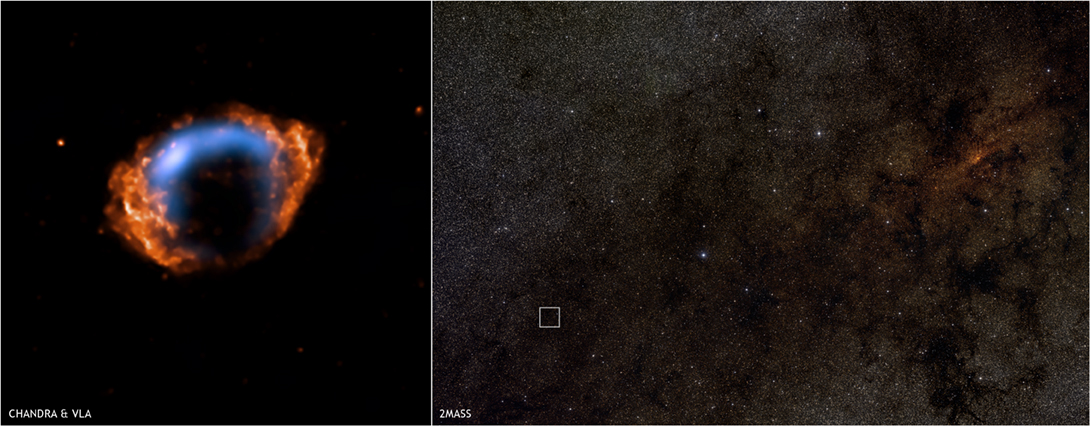
The expanding remains of a supernova explosion in the Milky Way are shown in this composite image, on the left, of the supernova remnant G1.9+0.3. NASA's Chandra X-ray Observatory image obtained in early 2007 is shown in orange and the radio image from NRAO's Very Large Array (VLA) from 1985 is in blue. The difference in size between the two images gives clear evidence for expansion, allowing the time since the original supernova explosion (about 140 years) to be estimated.
This makes the original explosion the most recent supernova in the Galaxy, as measured in Earth's time-frame (referring to when events are observable at Earth). Equivalently, this is the youngest known supernova remnant in the Galaxy (140 years old), easily beating the previous record of about 330 years for Cassiopeia A. The rapid expansion and young age for G1.9+0.3 was recently confirmed by a new VLA image obtained in early 2008.
The original supernova explosion was not seen in optical light about 140 years ago because it occurred close to the center of the Galaxy, and is embedded in a dense field of gas and dust. This made the supernova about a trillion times fainter, in optical light, than if it had been unobscured. However, X-rays and radio waves from the resulting supernova remnant easily penetrate this dust and gas.
On the right is an infrared image from the Two Micron All Sky survey (2MASS), where the colors represent different infrared wavelengths. The center of the galaxy is the bright red spot in the upper right and the location of G1.9+0.3 is shown by the box in the lower left, less than two degrees away (corresponding to about a thousand light years at the distance of the galactic center). More stars are visible in this 2MASS image than in an optical image, where obscuration by dust and gas is more prominent. Also, note the difference in orientation: in the close-up view of G1.9+0.3, north is up and east is to the left, while in the 2MASS image north is to the left and east is down.

This composite NASA image of the spiral galaxy M81, located about 12 million light years away, includes X-ray data from the Chandra X-ray Observatory (blue), optical data from the Hubble Space Telescope (green), infrared data from the Spitzer Space Telescope (pink) and ultraviolet data from GALEX (purple). The inset shows a close-up of the Chandra image. At the center of M81 is a supermassive black hole that is about 70 million times more massive than the Sun.
A new study using data from Chandra and ground-based telescopes, combined with detailed theoretical models, shows that the supermassive black hole in M81 feeds just like stellar mass black holes, with masses of only about ten times that of the Sun. This discovery supports the implication of Einstein's relativity theory that black holes of all sizes have similar properties, and will be useful for predicting the properties of a conjectured new class of black holes.

Globular star clusters, dense bunches of hundreds of thousands of stars, have some of the oldest surviving stars in the universe. A new study of globular clusters outside our Milky Way Galaxy has found evidence that these hardy pioneers are more likely to form in dense areas, where star birth occurs at a rapid rate, instead of uniformly from galaxy to galaxy.
Astronomers used NASA's Hubble Space Telescope to identify over 11,000 globular clusters in the Virgo cluster of galaxies. Most are older than 5 billion years. The sharp vision of Hubble's Advanced Camera for Surveys resolved the star clusters in 100 galaxies of various sizes, shapes, and brightnesses, even in faint, dwarf galaxies. Comprised of over 2,000 galaxies, the Virgo cluster is the nearest large galaxy cluster to Earth, located about 54 million light-years away.
Astronomers have long known that the giant elliptical galaxy at the cluster's center, M87, hosts a larger than predicted population of globular star clusters. The origin of so many globulars has been a long-standing mystery.
"Our study shows that the efficiency of star cluster formation depends on the environment," said Patrick Cote of the Herzberg Institute of Astrophysics in Victoria, British Columbia. "Dwarf galaxies closest to Virgo's crowded center contained more globular clusters than those farther away."
The team found a bounty of globular clusters in most dwarf galaxies within 3 million light-years of the cluster's center, where the giant elliptical galaxy M87 resides. The number of globulars in these dwarfs ranged from a few dozen to several dozen, but these numbers were surprisingly high for the low masses of the galaxies they inhabited. By contrast, dwarfs in the outskirts of the cluster had fewer globulars. Many of M87's star clusters may have been snatched from smaller galaxies that ventured too close to it.
"We found few or no globular clusters in galaxies within 130,000 light-years from M87, suggesting the giant galaxy stripped the smaller ones of their star clusters," explained Eric Peng of Peking University in Beijing, China, and lead author of the Hubble study. "These smaller galaxies are contributing to the buildup of M87."
Hubble's "eye" is so sharp that it was able to pick out the fuzzy globular clusters from stars in our galaxy and from faraway galaxies in the background. "It's hard to distinguish globular clusters from stars and galaxies using ground-based telescopes," Peng said.

The Pinwheel galaxy, otherwise known as Messier 101, sports bright reddish edges in this new infrared image from NASA's Spitzer Space Telescope. Research from Spitzer has revealed that this outer red zone lacks organic molecules present in the rest of the galaxy. The red and blue spots outside of the spiral galaxy are either foreground stars or more distant galaxies.
The organics, called polycyclic aromatic hydrocarbons, are dusty, carbon-containing molecules that help in the formation of stars. On Earth, they are found anywhere combustion reactions take place, such as barbeque pits and exhaust pipes. Scientists also believe this space dust has the potential to be converted into the stuff of life.
Spitzer found that the polycyclic aromatic hydrocarbons decrease in concentration toward the outer portion of the Pinwheel galaxy, then quickly drop off and are no longer detected at its very outer rim. According to astronomers, there's a threshold at the rim where the organic material is being destroyed by harsh radiation from stars. Radiation is more damaging at the far reaches of a galaxy because the stars there have less heavy metals, and metals dampen the radiation.
The findings help researchers understand how stars can form in these harsh environments, where polycyclic aromatic hydrocarbons are lacking. Under normal circumstances, the polycyclic aromatic hydrocarbons help cool down star-forming clouds, allowing them to collapse into stars. In regions like the rim of the Pinwheel -- as well as the very early universe -- stars form without the organic dust. Astronomers don't know precisely how this works, so the rim of the Pinwheel provides them with a laboratory for examining the process relatively close up.

The green and red splotch in this image is the most active star-making galaxy in the very distant universe. Nicknamed "Baby Boom," the galaxy is churning out an average of up to 4,000 stars per year, more than 100 times the number produced in our own Milky Way galaxy. It was spotted 12.3 billion light-years away by a suite of telescopes, including NASA's Spitzer Space Telescope.
Baby Boom is a type of galaxy called a starburst. Like some other starbursts, it is thought to be a collection of colliding galaxies. As the galaxies smash together, gas becomes compressed, triggering the birth of stars. In this multi-wavelength portrait, the color red shows where loads of new stars are forming in Baby Boom, and where warm dust heated by the stars is giving off infrared light.
Green (visible-light wavelengths) denotes gas in the Baby Boom galaxy, while blue (also visible light) shows galaxies in the foreground that are not producing nearly as many stars. Yellow/orange (near-infrared light) indicates starlight from the outer portion of Baby Boom. The red blob to the left is another foreground galaxy that is not producing a lot of stars.

Coronal jets are small-scale transient ejections of hot gases, or plasma, occurring in the solar atmosphere. During a typical event, about a million tons of matter are ejected at speeds reaching a million miles per hour over a few minutes' time. The jets are believed to contribute significantly to the mass flow constantly ejected by the Sun, known as the solar wind. Despite their relative simplicity, jets may serve as a paradigm for more complex and far larger events originating in the solar atmosphere, such as coronal mass ejections.
Until recently, all jet observations suffered from an inherent limitation: because they were observed from a single viewpoint, their complete geometry could not be determined unambiguously. This situation improved dramatically once the stunning images from the SECCHI instruments onboard the twin NASA/STEREO spacecraft became available in early 2007.
A unique polar coronal jet observation was made on June 7, 2007. Analysis of the images from the two distinct viewpoints of the STEREO spacecraft reveals an unmistakable helical structure in the jet. These pioneering, multi-viewpoint observations from STEREO provide the first conclusive evidence for the jet's helical geometry.
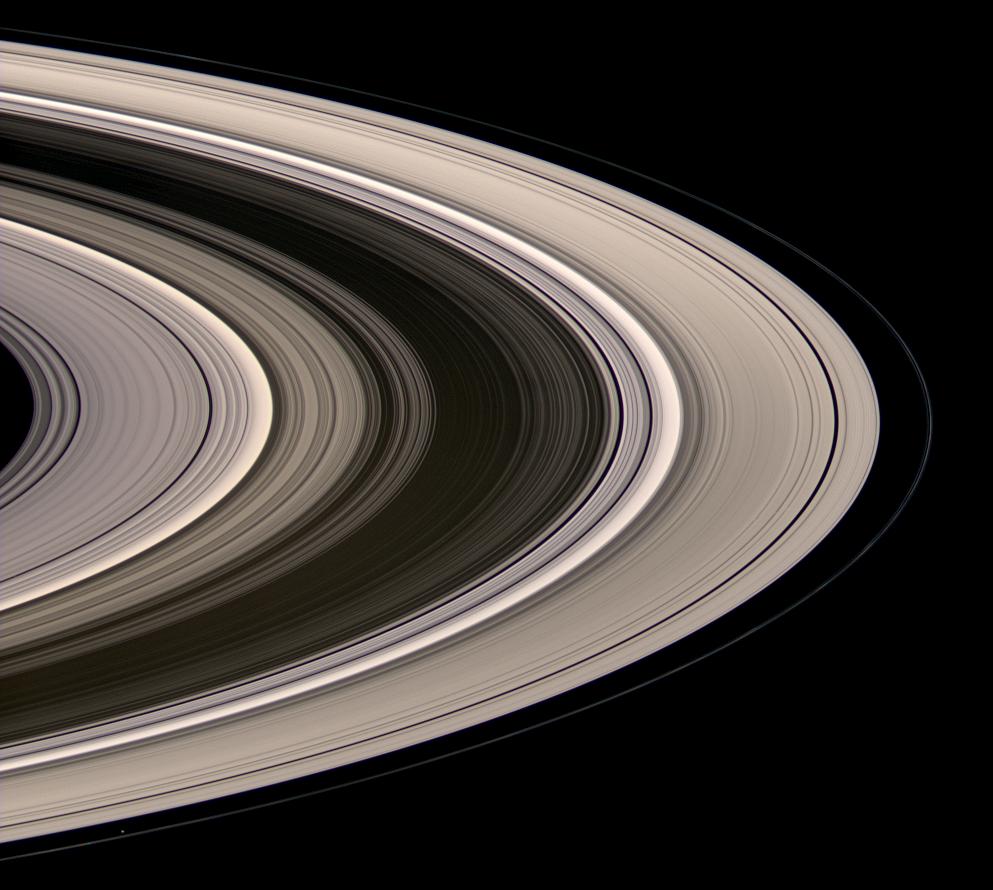
Saturn's icy rings shine in scattered sunlight in this view, which looks toward the unilluminated northern side of the rings from about 15 degrees above the ringplane.
The Sun currently illuminates the rings from the south. Some of the sunlight not reflected from the rings' southern face is scattered through the countless particles, setting the rings aglow.
The inner F-ring shepherd moon Prometheus (86 kilometers, or 53 miles across at its widest point) appears at lower left.
Images taken using red, green and blue spectral filters were combined to create this natural color view. Bright clumps of material in the narrow F ring moved in their orbits between each of the color exposures, creating a chromatic misalignment in several places that provides some sense of the continuous motion within the ring system.
The images were obtained with the Cassini spacecraft wide-angle camera on July 4, 2008 at a distance of approximately 1.2 million kilometers (770,000 miles) from Saturn. The Sun-ring-spacecraft, or phase, angle was 28 degrees. Image scale is 70 kilometers (44 miles) per pixel.

New hues are creeping into Saturn's northern cloud bands as winter gives way to spring there.
During its first four years of exploration, Cassini has made the Saturn system a familiar place to us Earthlings. The intrepid craft has returned more than 150,000 images since arriving in orbit in mid-2004. In this natural color image, the blues and grays of Saturn's northern hemisphere, so striking in early Cassini images, are diminishing in intensity with the slow change of seasons on Saturn, and are almost imperceptibly being replaced by pale shades of the colors commonly seen by Cassini in the planet's southern hemisphere.
This view looks toward the sunlit side of the rings from about less than a degree below the ring plane. Images taken using red, green and blue spectral filters were combined to create this natural color view. The images were acquired with the Cassini spacecraft wide-angle camera on April 23, 2008, at a distance of approximately 1.2 million kilometers (740,000 miles) from Saturn. Image scale is 68 kilometers (42 miles) per pixel.

This sweeping mosaic of Saturn's moon Enceladus provides broad regional context for the ultra-sharp, close-up views NASA's Cassini spacecraft acquired minutes earlier, during its flyby on Aug. 11, 2008. See PIA11114 and PIA11113 for the higher resolution views.
This false-color mosaic combines Imaging Science Subsystem (ISS) narrow-angle camera images obtained through ultraviolet, green, and near-infrared camera filters. Areas that are greenish in appearance are believed to represent deposits of coarser grained ice and solid boulders that are too small to be seen at this scale, but which are visible in the higher resolution views, while whitish deposits represent finer grained ice. The mosaic shows that coarse-grained and solid ice are concentrated along valley floors and walls, as well as along the upraised flanks of the tiger stripe fractures, which may be covered with plume fallout that landed not far from the sources. Elsewhere on Enceladus, this coarse water ice is concentrated within outcrops along cliff faces and at the top of ridges. The sinuous boundary of scarps and ridges that encircles the south polar terrain at about 55 degrees south latitude is conspicuous. Much of the coarse-grained or solid ice along this boundary may be blocky rubble that has crumbled off of cliff faces as a result of ongoing seismic activity. This mosaic complements the imaging coverage acquired during Cassini's July 2005 flyby of Enceladus by showing portions of the moon's south polar region and tiger stripes, or sulci, that were in darkness during that flyby (PIA06247).
The reversed lighting conditions over the polar region (compared to the July 2005 images) highlight features, such as fractures and ridges, that are barely visible in the July 2005 views, and vice versa. The four most prominent sulci (from top to bottom: Damascus, Baghdad, Alexandria and Cairo) appear as generally horizontal fractures near lower right, and they extend into the moon's night side. The mosaic is an orthographic projection centered at 63.0 degrees south latitude, 281.3 degrees west longitude, and has an image scale of 60 meters (196 feet) per pixel. The original images ranged in resolution from 28 to 154 meters (92 to 505 feet) per pixel and were taken at distances ranging from 5,064 to 25,949 kilometers (3,140 to 15,468 miles) from Enceladus.

This image shows the floor of an unnamed impact crater in Arabia Terra that has layered deposits. There are many craters in this region where layering is observed.
These layers are often exposed along the sides of large isolated mounds, small knobs and mesas, and other positive relief features. In some cases, the layering is expressed as narrow sinuous ridge-like structures along crater floors.
The presence of layered deposits is of particular interest because these materials are not likely to be related to the impact event, but rather post-impact infill of the crater. Modification of the deposits has now revealed layers of material.
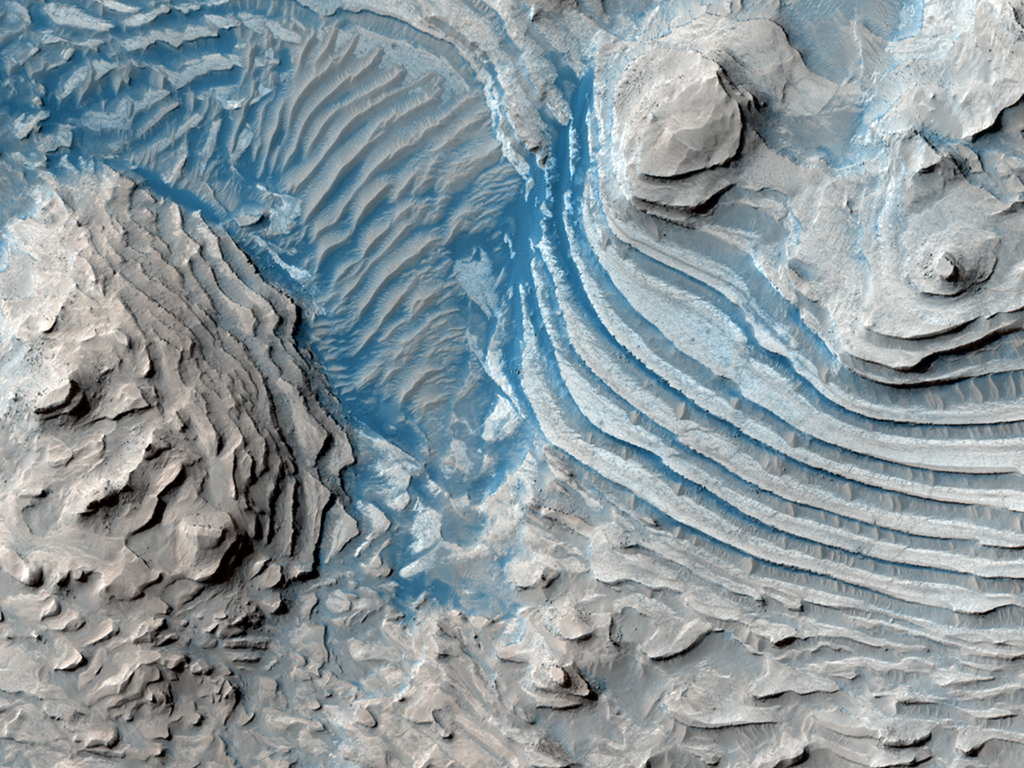
This image shows layered sedimentary rocks that fill an impact crater in the Meridiani Planum region of Mars.
These layered rocks may have formed through the accumulation of sediment (sand and dust) that were transported into this crater by blowing wind or flowing water. These sediments formed an extensive deposit that once covered the floor of the surrounding impact crater.
This crater is so large that the HiRISE image is entirely within it, and the crater rim is not visible. These sedimentary rocks were then eroded, likely by the wind. The original sand and dust were deposited in distinct layers within the crater; these layers now give the mounds their distinctive stair-stepped appearance, and are all that remain from this once extensive deposit.
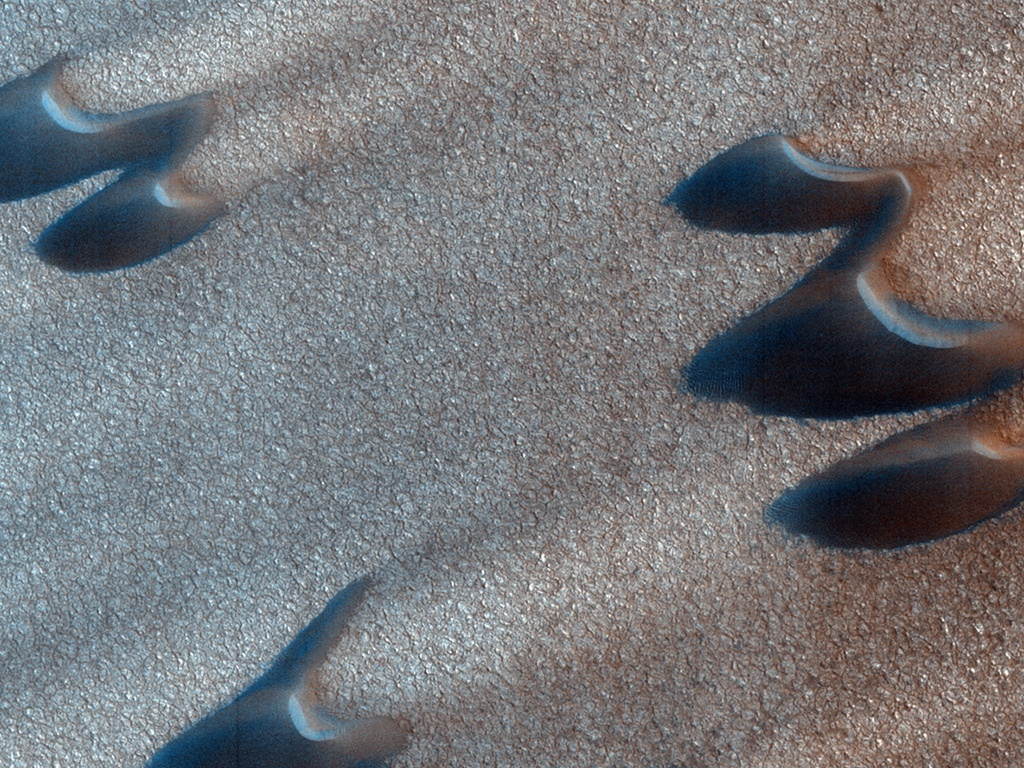
At high northern latitudes, shallow troughs in the ice-rich ground form polygonal patterns. The polygons form over many years as the near-surface ice contracts and expands seasonally.
On top of this patterned ground in this image are dunes. Loose sand and dust are blown across the hard-cemented surface until collecting and forming a dune. Streaks of dust are visible in this color subimage coming from the horns of the dunes, while the higher portion of the dune blocks the dust from being blown across the surface.
Small ripples are also visible, and the small bright spots are the remnants of the seasonal carbon dioxide polar cap that coats this area in the winter.
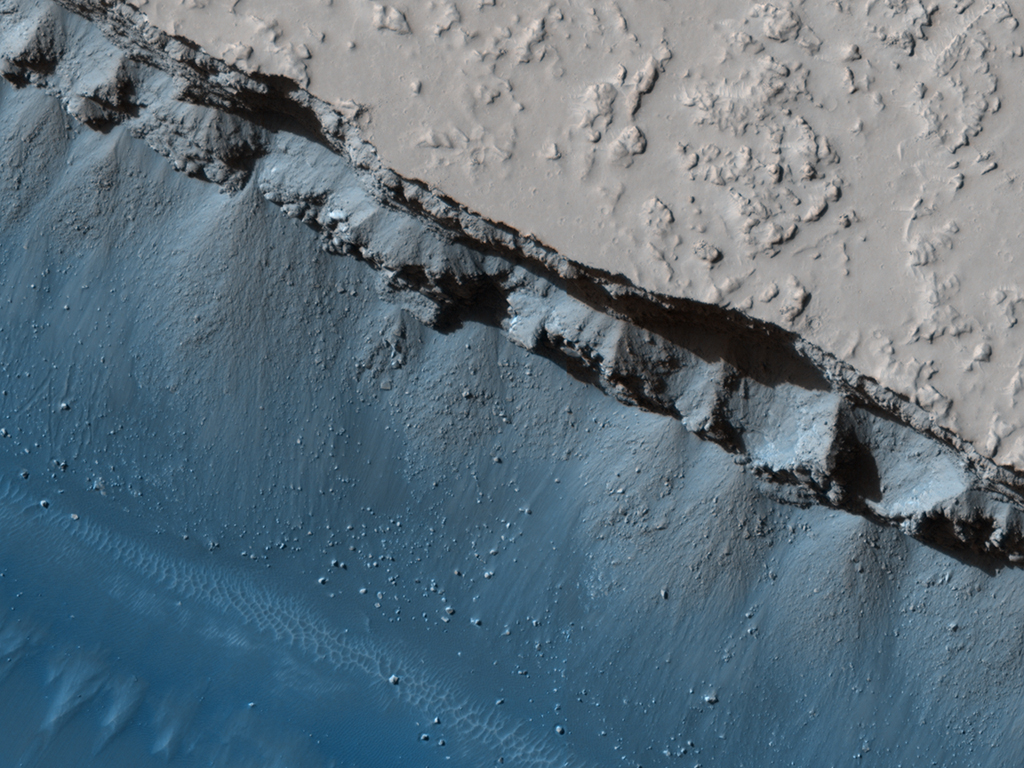
This observation is located at the head of the Athabasca Valles channel system, which lies just north of Mars equator in a low-elevation region known as Elysium Planitia.
Athabasca Valles has an interesting geologic history. It was probably carved by one or more catastrophic floods of water, but more recently, a flood of lava coursed through the channel system. Both the water and the lava erupted from a few discrete points (or vents) along the Cerberus Fossae, a 1600-kilometer (1000-mile) long network of extensional (or normal) faults. The two prominent troughs that cut across the southern end of this HiRISE image are part of the Cerberus Fossae. They are distinct fault segments that overlap at their tips, as one tapers in and the other pinches out.
They were not always as wide as they are today. Erosional processes have widened the troughs over time. Major eruptions occurred along both of the fault segments seen in this image, though they occurred to either side of the imaged area itself. Lava that erupted from the western vent covers the northern half of the image. The lava has raised, lobate margins and is slightly darker in tone than the older cratered plains it embays. The lava also has a banded appearance of subtly contrasting lighter and darker tones, that correspond to variations in surface roughness. The bands are concentric to a vent located immediately west of the imaged area. Unfortunately, vents along the Cerberus Fossae are not well preserved.

Midnight Sun(s)
This panorama mosaic, taken by the Surface Stereo Imager on board NASA's Phoenix Mars Lander, documents the passage of the midnight sun over several days.

Arctic Eclipse
NASA's Terra satellite was rounding the top of the globe, making its way from the eastern tip of Siberia and across the Arctic Ocean towards northern Norway and northwest Russia, when it captured this unique view of a total solar eclipse on Aug. 1, 2008.
In the area shown in the image, the sun was completely obscured for about two minutes. As Earth rotated, the shadow moved southeast across the surface. At the same time, the satellite crossed the Arctic with its path nearly perpendicular to the eclipse.